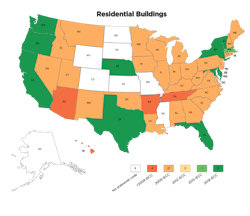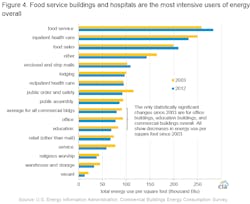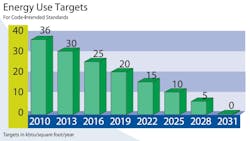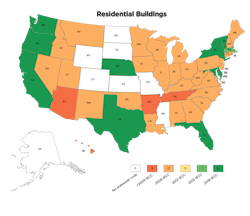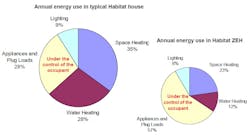Zeroing In on Net-Zero Buildings
By PETER D'ANTONIO, P.E., CEM, LEED AP, PCD Engineering, Longmont CO
This year, 2020, marks a milestone in the quest for net-zero energy buildings (NZEB). Dedicated initiatives like the American Society of Heating, Refrigeration and Air Conditioning Engineers (ASHRAE) 'Vision 2020' and the '2030 Challenge' are helping challenge the industry to keep focus.
Buildings are a big contributor to climate change, responsible for roughly 40% of both energy and carbon emissions nationwide as well as globally. Couple this with the U.S. Environmental Protection Agency’s estimate that the average commercial building wastes 30% of the energy it consumes, and the problem becomes clearer. Combating climate change will not be successful unless energy and building emission reductions are addressed.
A NZEB is one that generates as much energy as it uses annually. In other words, it’s a building that uses as much as it consumes. It’s a building that strikes a balance as illustrated in the figure below, between energy used and generated. All buildings use energy, even NZEBs. NZEB use on average energy use intensity (EUI) of around 18-23 kBtu per square foot per year. For comparative purposes, that is the energy equivalent of the average annual energy use of three commuter vehicles per 10,000 square feet of NZEB.
Zero energy is technologically feasible in every market sector, building size and climate zone in the United States, although certain types of buildings are more energy intensive than others, as shown in the Figure below, and thus more difficult to achieve NZEB status. Any building can realize NZEB status, if you have enough green. That includes green in the form of greenbacks or green in the form of land for placement of off-building renewable energy. For this reason urban sites are particularly constrained of area for renewable energy placement needed to achieve NZEB.
The path toward large scale adoption and rapid zero energy for the masses will only be realized if it can been accomplished cost-effectively and if it is incentivized. Building a NZEB for relatively comparable costs as a code-compliant building requires it to be a high-performance building.
Return on investments for deep energy efficiency have been shown to be 6 to 12 percent, rising as high as 33 to 36 percent according to a 2013 financial study commissioned by The District of Columbia Department of the Environment. These are compelling returns. Other benefits are energy-efficient buildings may command a resale premium in certain markets, and organizations that align with clean energy and energy efficiency improve shareholder value. This is evidenced by recent corporate pledges by Apple to be carbon-neutral 2030 and from Amazon by 2040 which come after Microsoft achieved it in 2012. Microsoft has recently upped the ante declaring their intent to be carbon negative by 2030.
The exciting part is that an NZEB is possible today. However, there is confusion in the marketplace on the definition of NZEB, as NZEB can be quantified using several parameters. It is useful to think of these definitions in the context of grid-connected solutions, as off-grid NZEB are more difficult to achieve due to energy storage technologies available today. The four basic definitions are:
- Site – Includes site-based energy use and production;
- Source – Includes not only site energy, but the energy used to make and transmit it to the site, which better reflects the overall picture;
- Cost – Zero energy does not mean zero utility bills. Fixed utility meter costs and demand charges play into utility cost. For utilities that offer net metering, payment may be issued back to the customer, but if the kWh is not banked the customer may have to pay for months where production does not exceed use. In a cost-based NZEB the net cost to the building owner is zero when factoring in owner payments to the utility for use and utility company payments back to the owner for over-generation;
- Emissions – This definition includes the carbon dioxide emissions factors and various fuel sources used, and can also include other emissions such as nitrogen oxide and sulfur oxides. To be net-zero emissions, the produced or purchased renewable energy must offset the emissions of the energy used. Other expanded definitions include emissions generated from construction of the building and the embodied energy of the structure, as well as emissions associated with building user transportation energy.
All these options are clouding the understanding of zero energy in the marketplace. One definition is needed to simplify tracking, verifying and market understanding. Until a single definition is agreed upon by public and private interest, growth will be slowed.
Drivers in policy include the Energy Independence and Security Act of 2007 (EISA) which established a goal of net-zero energy for all new commercial buildings by 2030, specifies a zero-energy target for 50% of U.S. commercial buildings by 2040, and net-zero for all U.S. commercial buildings by 2050. The EISA was followed with private sector initiatives like the '2030 Challenge' in 2009, and the associated American Institute of Architects 2030 Commitment. That began by calling for incrementally reducing energy use, starting with a 50% reduction over existing building use, and increasing reductions up to 2030. The 2030 Challenge is currently calling for an 80% reduction in fossil fuel consumption for new buildings and major renovations, 90% by 2025, and carbon neutrality using no fossil fuel energy to operate in 2030.
ASHRAE published its historic Vision 2020 Report in 2008. That document set out requirements for developing the tools by 2020 for market-viable buildings by 2030. In it ASHRAE’s board of directors approved the energy use targets shown in the figure below as drivers for its code-intended standards 90.1 and 189.1. A target of zero represents a NZEB.
Juxtaposed to ASHRAE’s EUI targets is an illustration below of the overall improvement of Standard 90.1 from its inception through the 2016 version where a value of zero also indicates a NZEB. The results are clear that ASHRAE has fallen short and is failing in its policy. From this perspective current energy codes are archaic upon release. 2030 targets are simply not going to be reached without a fundamental restructuring of policies, standards and codes.
Another realization is most U.S.-based governments are not doing their part to adopt energy codes in step with the lagging ASHRAE advancement, further slowing the uptake and ability to reach NZEB by 2030.Source: Roadmap for the Future of Commercial Energy Codes
The figure below lists the status of commercial code adoption by state in the United States. 16% of states don’t have a statewide energy code, and only 10% have adopted the 2016 code which targets a normalized EUI of 50 kBtu per square foot per year, over double that needed for a viable NZEB of today. State energy code adoption for the residential sector is worse than that described for the commercial sector.
It is clear a national zero-energy standard is needed now.
One with flexible policy solutions, one that provides outcome-based, measured compliance and enforcement using techniques such as ongoing commissioning, metering and monitoring. The International Green Construction Code is a start with such ongoing measurement requirements, but less than 10% of states have adopted it. All states must adopt at least the latest version of the International Energy Conservation Code and International Green Construction Code now.
Energy and climate change simply is not a priority for governmental leadership, and this must change.
In addition to acceleration of NZEB energy standards and code adoption, if NZEB are going to advance, several things are needed.
As mentioned previously, NZEB are limited in urban constrained sites, limiting on-site renewables. The ZNEB definition needs to be expanded to include zero net energy districts (NZED). Bridging design to operations needs to be addressed through the aforementioned performance, outcome-based codes. If a national net-zero energy code will not be developed, bolt-on net-zero code need to be adopted at local and state levels. A formal, central organization to recognize and provide a clearinghouse of NZEB data would be useful and require standardized data collection.
By now, it shouldn’t surprise that zero energy buildings are scarce even today. How many zero energy buildings are there out there? Not many, according to leading sources.
The New Building Institute (NBI) annual Getting to Zero Energy Buildings List was recently released with nearly 700 zero energy verified and emerging buildings. NZEB projects are buildings with a performance that has been certified by a third party or verified by NBI. However, only 136 of the 700 buildings meet the criteria of NZEB, up from 35 in NBI’s 2014 getting to zero report. The remaining 547 are classed as emerging projects. Society can and should be doing better than this.
One encouraging statistic is over 35% of the projects are buildings over 50,000 square feet, indicating larger projects are becoming more common.
The Living Building Challenge, a program that certifies NZEBs, shows 57 such certified zero energy projects on their website, up from a paltry 31 in 2016. A web search of the DOE’s Building Performance Database sinks still lower, providing an esoteric and unnavigable format that leaves the user frustrated regarding net-zero energy achievements and requires a login and painfully long 14-character password to access the database. The more user-friendly U.S. Department of Energy office of Energy Efficiency and Renewable Energy Zero Energy Building’s Database, formerly part of the aforementioned Building Performance Database, no longer exists.
On the residential front, the DOE’s Zero Energy Ready Homes Program provides a further barrier, namely that Zero Ready Energy Home Program requirements and compliance with the Energy Star for Homes Program are required. These requirements include dictating construction techniques among other things. If a home achieves zero-energy, it shouldn’t be subject to program requirements, it should be celebrated. More accessible data and simpler certification for NZEB are needed in the marketplace.
Knowing there are achievements in net-zero building, how is a NZEB created most cost-effectively?
A cost-effective path to net-zero can be described using this mnemonic:
- N ature – Orientation & Passive Energy;
- E nvelope – Outdoor/Indoor Boundary;
- T echnology – Efficient, Controllable Systems;
- Z eal – Motivation;
- E ducation – Behavior;
- R esearch – Model & Analyze;
- O bservation – Track & Verify.
Nature – Orient the building properly on the site to harvest passive energy and daylighting sources;
Envelope – Build the building envelope air-tight and ventilate using energy recovery. A high-efficiency envelope with high R-values and strategically located glazing positively affects the heating, cooling, and lighting, which represent over half of a building's energy consumption per the figure below;
Technology – Install efficient, variable capacity HVAC and DHW systems and automate them to track the load and occupancy all year;
Zeal – Energy and enthusiasm in pursuit of the net-zero objective is what makes NZEB possible;
Education – Beyond heating, cooling and lighting, the remainder of the energy use pie slices including DHW and plug loads are occupant-based. Also, heating, cooling, and lighting use are secondarily affected by occupant behavior. This speaks to the idea that buildings don’t use energy, people do. The more control a user has over their indoor environment, the more range of comfort they will accept. Acknowledge behavior, educate building users and provide feedback on their choices. Utility bills have provided such feedback and behavioral modification. With the digital revolution, apps have the power to offer real-time reminders to influence energy use decision-making;
Research – Analyze the interaction between a building envelope and its surroundings as well as the interactions of building systems within the envelope using the tools of energy analysis and computer modeling. This is important because each building behaves differently in its climate and has different functions and needs;
Observation – There is an old maxim that says you can’t manage what you can’t measure. Ongoing monitoring and commissioning are vital for proving and maintaining energy performance.
Source: EIA
To solve the net-zero energy equation cost-effectively, look at which end-uses offer the most opportunity for reduction. Below are two NZEB examples which offer insight into the building systems used, challenges, successes and lessons learned.:T
he Habitat for Humanity home in Arvada, CO, for which the author was Engineer of Record, achieved net-zero energy on a source basis. The project was a public-private partnership between Habitat for Humanity of Metro Denver and the National Renewable Energy Laboratory (NREL). The home completed construction in 2006 and was an early example of the possibilities achievable for cost-effective net-zero energy for the masses.
The 1,200-sq-ft home featured R-40 walls double 2x4 construction, R-60 ceilings, a gas wall heater and supplemental electric baseboard, energy recovery ventilation, a 4 kW photovoltaic system and solar thermal domestic hot water. The home energy use was monitored. The figure below Illustrates the importance of user behavior in achieving zero energy, as occupant behavior enabled this project to reach net-zero. The occupants learned through the monitoring results and understood they had an impact on the success of this project. Plug loads represented a majority of the building energy use, as can be typical in a ZNEB. This illustrates that addressing plug loads becomes essential in a NZEB.
One of the drawbacks of this project was the lack of a cooling system; indoor temperature could climb into the high 80s during the peak of summer. So while net-zero was obtained, total comfort was not. Building comfort is mandatory if ZNEB are going to be seen as viable and successful in the marketplace. A building is not truly a high-performance building unless it performs highly with respect to comfort, maintenance and energy.
For commercial buildings the energy end-use breakouts, potential dominance of unchecked plugs loads and approaches to achieving NZEB are similar to those explored for residential building. A figure of typical commercial building end-use is provided below. Commercial buildings represent the largest building type of all buildings types in the United States and, due to their relative lower EUI as compared to other building types, offer a large opportunity for impact. Examining a chart of the energy end-use
yields some revelations. When targeting the most cost-effective opportunities, focus on largest end-uses of lighting, heating and plug loads which offer the largest opportunities. Employ reduction strategies of envelope and internal gains load reduction through selection of more efficient envelopes and building systems to decrease these end-uses. If plug loads are not optimized, as with the Habitat example above, plug loads become the dominant end-use. A low-energy building will result, but one that will have difficulty achieving net-zero energy cost-effectively on a site-energy basis.
Source: PCD Engineering
The Mapleleaf Orthopedics medical office facility completed in 2007 achieved a verified net-zero energy level of building performance of 16 kBtu per square foot per year. It employed south-facing orientation on the site, thermal mass, daylight penetration into 90% of indoor spaces, ground source heat pumps, energy recovery ventilation, high-efficiency lighting and controls and a 30 kW PV system. This 7,000-sq-ft building is an early illustration of the shift to all-electric buildings with use of on-site renewable energy which is important to affecting climate change and distributing the energy grid. The project architect was HGF Architects. PCD Engineering provided energy modeling, LEED consulting, commissioning, and verification of energy performance.
Fifteen years after Mapleleaf Orthopedics was conceived, all-electric buildings are getting support from changing policies that restrict new building gas connections, the decreasing cost of renewable energy and electric utility solar incentive programs. Additional drivers of the ongoing shift to all-electric buildings include improvements in electric cooking and heat pump space heating appliances, indoor air pollution/safety issues from fossil fuels, and increased contribution of natural gas to greenhouse gas emissions.
These two projects in Colorado and the newer, net-zero Unisphere project in Maryland, featured in the October 2020 issue of HPAC Engineering, even with the apparent lack of accelerated progress, still show the possibilities of today and the promise of future NZEBs.
This discussion needs to continue with all stakeholders uniting to accept and address these issues to reach net-zero goals by 2030.
##########
Based in Longmont CO, the author, Peter D'Antonio, is president of PCD Engineering and a member of HPAC Engineering's Editorial Advisory Board. Contact him at [email protected].
